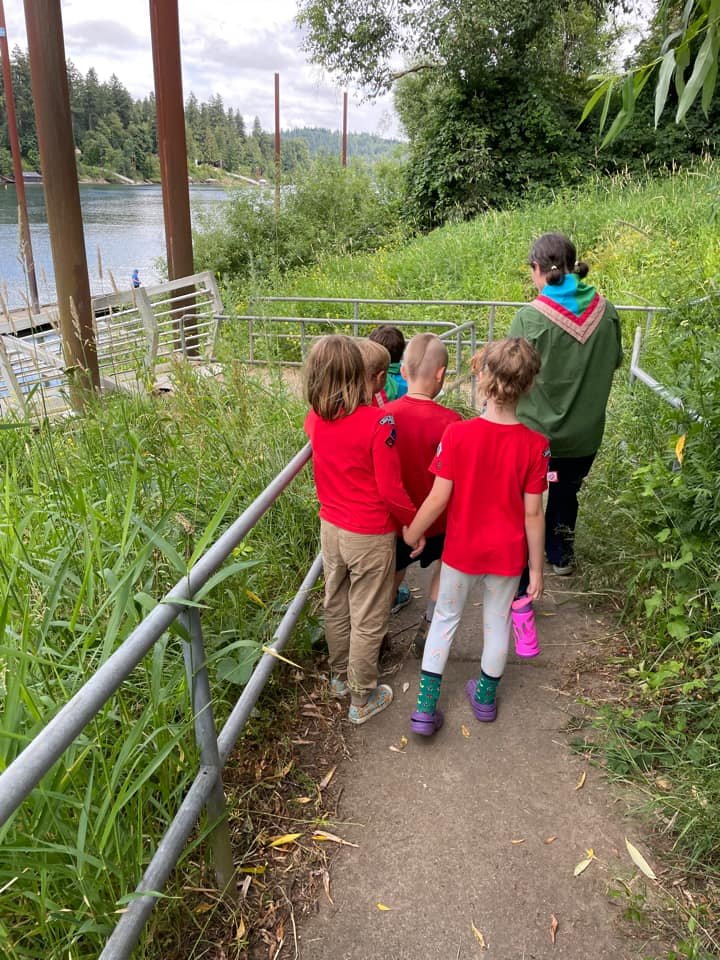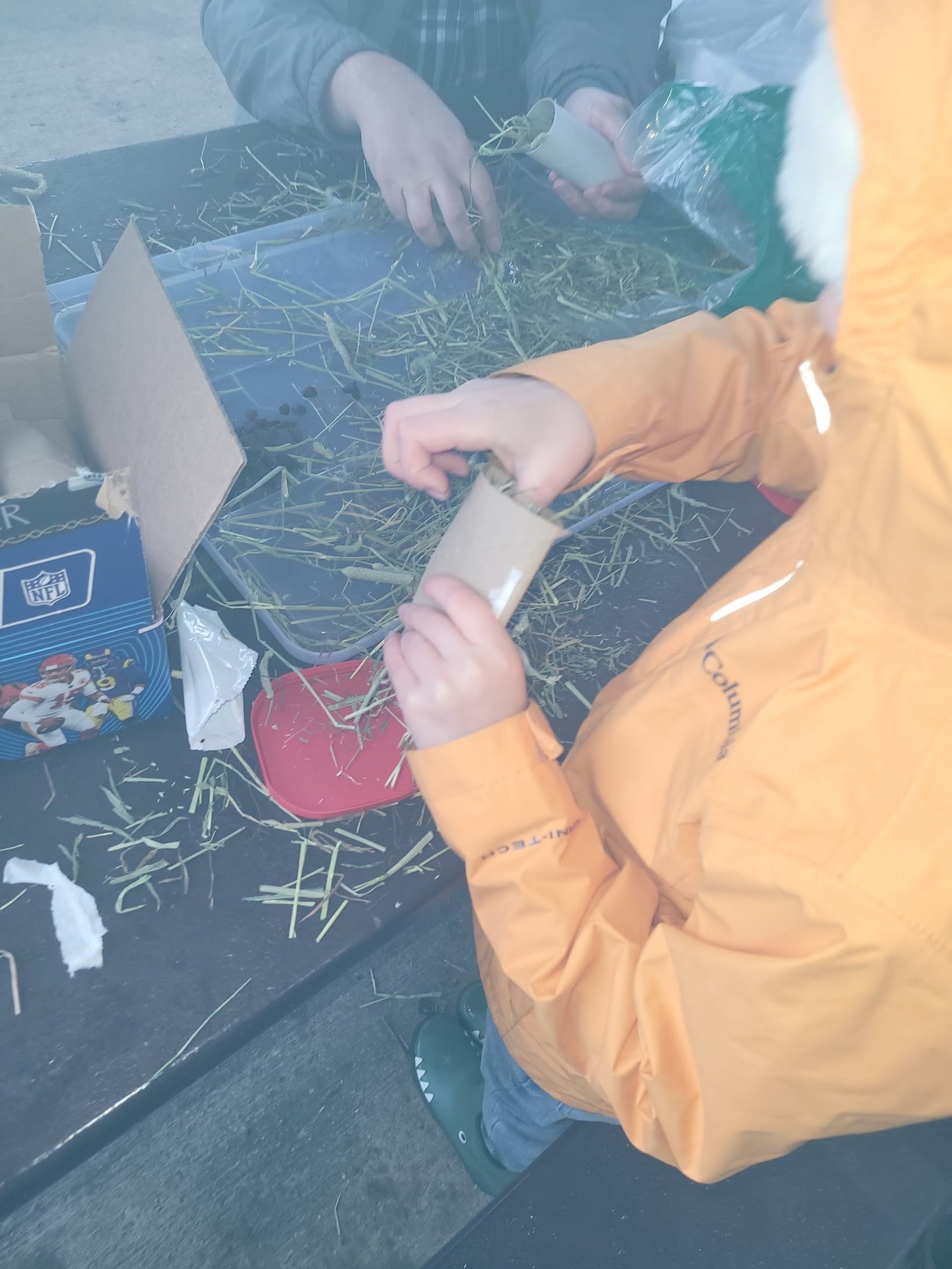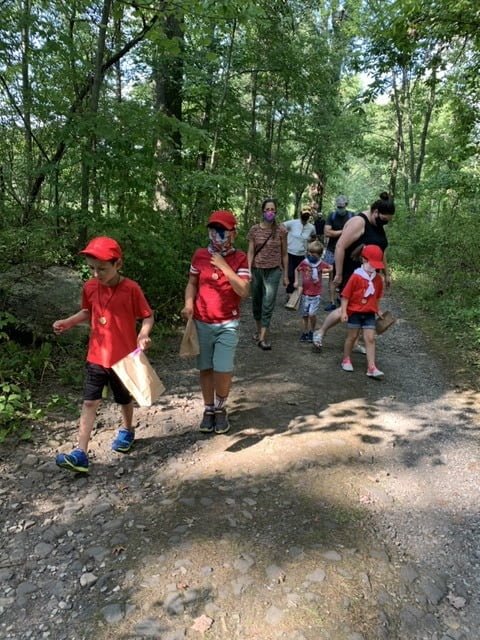Otter Tan Paw- How to Adapt It
The Tan Otter Paw is based on making crafts, but if you have never selected crafts for young children, especially children with fine motor delays, this one can be tricky. Here, I am going to share with you craft ideas you can use for this badge. I am also going to give you tricks and tips you can use if you have otters with fine motor delays or lack of coordination that would make typical craft activities harder. I will be separating these ideas into “Typical” and “Adjusted.” The notes for the Typical badge activities are ones for use with typical 6 year olds, they may still be tricky if you entire otter raft is only 5, so feel free to use the adjusted plan if it seems like it would fit your group better. The Adjusted ideas are ones more likely to work if your otters are younger, have some delays or learning disabilities. These activities still meet the requirements of the badge, but may do it in a way you didn’t consider before.
If you have one otter who needs the requirements adjusted, I recommend doing an adjusted activity for the entire group. This makes your child who needs the adjustment feel the most included possible. It will also not harm your other otters, as I’ll explain as we go. Typical children will generally excel at the adapted activity and if it is “too easy” do more with it.
Tan Paw – Handicraft- Requirements
- Make art showing a scene or event.
- Create a picture of your home.
- Make a Thank You card and deliver it.
- Make a map or diagram.
- Create trail signs using rocks or sticks.
- Make a model.
- Make two craft items.
- Make a bird feeder from reused item
- Tie two different knots.
- Display a collection with at least 25 things.
- Participate in a service project making or collecting things to donate.
Make art showing a scene or event
Let’s start with the first requirement, making art that shows a scene or event. For your typical raft, you may be able to just pull out crayons and paper and ask them to draw themselves at a raft meeting or camping trip. As an adjusted activity, you need to assess how much you need to adjust. With a child with a mild fine motor issue, giving the entire raft markers instead of crayons might be enough if the child simply struggles with gripping typical small crayons or pencils.
Another adjustment you can do this is either a collage or painting activity. Your otters can paint a scene using blue paint for the sky and green paint for the grass. This can get very messy- so remember to purchase washable paint! Another option is to provide paper to rip up and glue sticks to use to make a collage. Ripping paper is easier than cutting it, but if you have a more delayed child, you may need to provide some paper that is already ripped into smaller pieces that they can just glue down. Green paper for grass and blue for the sky are essential. You can also provide other colors so children can all add simple trees or flowers or other objects to their collage.
Create a picture of your home
For this requirement, all the tips for the first requirement may work. Another option for children with fine motor delays is to have an adult use a black marker to create an outline of the child’s house on paper. If the child can verbally explain how many windows to add or what shape the house is, to direct the adult, even better. You then have a unique coloring sheet that your otter can fill in with markers, crayons or paint. Not every adult is great at a skill like this on the fly- so plan ahead which parent or leader can help with this step. If other scouts want the same help, provide it, otherwise you send a message that something is wrong with the otter you are helping.
Make a Thank You card and deliver it
Thank you cards are one of the easiest to adapt activities. You can provide stickers, and stamps for all of your otters to use that eliminates the need for writing or drawing. For my group, I like to provide the folded over paper, markers, crayons, stickers and stamps for everyone to use what they choose. I help otters who are confused to figure out where to start. Even with typical children, I find it is helpful to provide an example that I have made that the children can choose to copy if they desire. Younger scouts and those who are struggling with learning to write may choose to use a stamp that says “Thank You” on it, or to copy those words from my example.
I used to work with an otter with dyslexia. She had good fine motor skills, but was behind in reading and writing. However, she could copy words down just fine, and happily copied my example for cards and letters, even though she couldn’t read it. Her work looked the same as any other guide, but she was working a lot harder, as her brain wasn’t holding onto the words for her and she had to slowly copy each letter. However it was her choice to do the project that way, and she was very proud of her work. It is also reasonable to adjust this card to not require words at all, and to let otters draw pictures, or to have them ask an adult to add the words when they are done decorating the cards.
Make a map or diagram

Making a map or diagram can be a rather tricky task. For typical otters who are 6 or 7, they may be able to draw a map of their home or yard or campsite after you provide an example. Consider creating a map of your meeting space on a large piece of paper or white board and show the children how you draw each item in the space from an arial view and explain how you put things where they are in relation to other things. However, this level of visual perceptual skill does not develop equally with humans. I know several adults who can barely read a map, much less make one. So, if you have several otters who are younger or have some delays, drawing a map may be too difficult.
On the other hand, a diagram can be many different things. One option for adapting this activity, is to use a poster board or white board to have all of your otters make a graph or diagram together. For example, you can have them diagram the life cycle of a butterfly or frog by adding stages to a single poster.
An otter with fine motor delays could use a do-a-dot marker to add the egg stage to start the cycle. Then each otter adds a single step. If you have a variety of art skills in your group, this may work. However, keep in mind that the adult stage of those animals can be hard for most 5 year olds to draw. Stickers may make it possible for every otter to create their own diagram without help or drawing.
You can also choose to have your raft graph their favorite color, food or animal. You provide the graph, and have each otter add a stamp, sticker or dot for their own favorite to the graph. Having leaders or siblings add information to your graph can make it more interesting to read and analyze together. Be sure to discuss which color has the most votes and which has the least.
Create trail signs using rocks or sticks
As long as you provide an example your otter can copy, this activity may be the most friendly one for otters with challenges. Basically, all the really need to do is create some arrows out of found items to point along the path. If for whatever reason you have an otter who has trouble reaching the ground to make trail signs, for example they are in a wheel chair, consider having them make their signs on a table, or bench. They may also be able to use a reacher or stick to position their objects on the ground.
If you need a little help with learning trail signs, this post we created for pathfinders has a lot more information.
Make a Model
There are many many ways to have your otters make a model. Classic activities including making small wooden cars that roll, or boats that float. Each of those can be very rewarding but tricky. If you are considering kits for those, look carefully for ones that seem like a child can assemble them. If you choose to do a more complex model, you can let your otters make them at home with the help of their grown ups. Then they can bring them in to share and roll or float them together as a group. By having every child receive parental help, they each get the exact amount of help they need.
However, this activity can be accomplished in other ways. One activity we have enjoyed is using Lincoln logs to let the children learn to build small log cabins. The thing I like about that activity, is that we can pull out the Lincoln logs for multiple meetings. A leader or older scout shows the otters how to build with them, and then we set them up to free build. Lincoln logs are harder than they look to put together. Repeating the activity means that otters who struggle with it the first time can try again and again until they can build with them.
You can also choose to use Lego Duplos, K’nex or other building blocks for the children to make their model. This open ended building time can also be relaxing and enjoyable for your group to do as part of a meeting where you have other, more adult driven tasks.
If your otters engage in imaginative play while building, that is wonderful for their social skills and general development. Don’t feel you have to rush them on to another activity quickly if they are enjoying this one. Otters tend to do a lot of activities very quickly, having something like this that can fill all the time left in a meeting where you have already completed your other goals is great.
Make two craft items
This requirement is beautifully vague so you can adapt to your group. If you have otters with significant fine motor delays, keep that in mind when choosing a craft. Crafts that work best are ones that are both easy and open ended. Open ended means that the child determines when they have finished and that the final product does not have to look like the example.
Simple crafts include stringing pony beads onto pipe cleaners to make bracelets or painting small ornaments. You can also have otters make crafts with stickers, which are often easier to manage than drawing or painting. You can also let them make small dishes to hold jewelry from air dry clay or paint rocks to be paper weights.
I often do this goal in December and we get kits for holiday crafts and that takes the stress out of planning. Many years we made ones with foam stickers that were easy for every child, especially the children with short attention spans and delays.
Make a bird feeder from reused items
The most important thing about helping a child with a project, is setting them up for success. Choose your project carefully and make sure to help your guides as much as they each need, but not more than that. There are dozens of ways to make a bird feeder from plastic bottles and other reusable items. Make one yourself and think through how much hand strength and coordination is needed for the one you have chosen. If it is too hard, consider other options or how to prep the materials to make it a little easier. This may be another time to ask your grown ups to assist their otters.
Tie two different knots
The usual knots to teach otters are the figure 8 knot and the square knot. However, you can choose any knots that make sense to your group. Remember, the thicker the rope, the easier it will be for the otter to hold it and see the knot. Tying knots in thread or string is MUCH harder than with rope. So, choose your rope carefully. If you work on tying two ropes together, make sure the ropes are two different colors to make it easy for the otters to tell which rope is which while working with them.
Display a collection with at least 25 things
For a typical otter this collection could be a book of pennies, stamps or Pokémon cards. The main advice for this activity is to give your parents plenty of warning that they will need to work on this at home. Set a date a month or more away and remind parents to be working on this with a specific date in mind when they should bring them to a meeting to share.
If your special needs otter struggles with creating a collection this large, you may choose to allow them to present a smaller collection. The bigger goal for the otter is to present this collection to the group. The size of the collection is not the important part. A collection of trains, matchbox cars, hats or rubber ducks all count too. Remember, many neurodivergent kids have unusual collections.
Participate in a service project making or collecting things to donate
This requirement should be easy to meet, as long as you don’t expect your otters to make something too complex. A few ideas that work for this requirement:
Stuff alfalfa hay into a toilet paper tube roll to donate to rescues for guinea pigs or rabbits.
Have otters bring in cans of soup or fruit to donate to the local food bank. These can be turned into care packages by putting them in wine bags with multiple slots or other containers. Our group likes to have each age level add a different item to the care packages to make it a multiage event.
Make cards to hand out at a group home or nursing home. These can be done with stamps or stickers to make it easier for otters with poor fine motor skills.
Do a towel drive for your local animal shelter. Otters can collect towels from their homes and roll them up to put in a donation box to deliver.
Need More Help?
You can find more help with adapting scouting activities and badges in our Leader Guide for Accessible and Adaptive Scouting. We even offer an Individualized Scouting Plan you can fill out with your leaders and parents. This plan can help you determine in advance ways you will adapt badge work and prepare for special needs that may arise with activities like camping and hiking.

